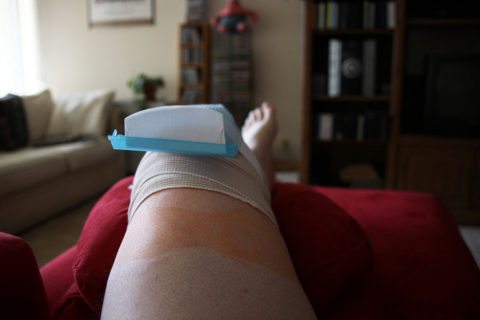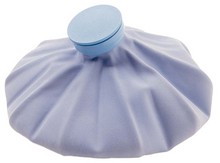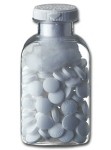For the life of me, I can never remember which to use when.
Is it ice on sore muscles and heat to relax pinched nerves? Or vice versa?
Once and for all, I’m putting it someplace in writing, so I’ll have it as an easy reminder.
Here’s the scoop on when to use a ice therapy or heat therapy to treat aches and pains…
When To Use Ice Therapy
- Use Ice To Relieve Acute Pain: If you have pain in one specific area that strikes out of the blue (like your back, knee, etc.) reduce swelling & inflammation with ice.
- When To Apply: Ideally, you should always apply ice within 1 hour of the ache, pain and soreness setting in (like after a workout).
- A Good Regimen: Ice for 15 minutes max, then 30 minutes without. Do this up to 4 times a day, as needed. For up to 2 days max. (If you still need pain relief, then switch to HEAT (below).
- How It Works: Cold temperatures reduces nerve-cell activity while constricting blood vessels to ease swelling.
Tips For Using Ice On Sore Spots
- Apply Cold Compress To Sore Spot: Help to eliminate a bad bruise by applying ice directly to the sore spot. The ice decreases
 blood flow to the area. Since a bruise is basically a build-up of blood under the skin, you’ll effectively be making the bruised area smaller.
blood flow to the area. Since a bruise is basically a build-up of blood under the skin, you’ll effectively be making the bruised area smaller. - Don’t Put Ice Directly On Skin: Use an ice pack, cold compress, or a bag of frozen vegetables wrapped in a towel. Don’t put ice directly on the skin.
- Elevate Your Injured Area If Possible: If the pain is in one of your limbs (hand, finger, toe, etc.), you should elevate the limb higher than your heart if possible for 24 hours after the injury to reduce swelling and pain.
When To Use Heat Therapy
- Use Heat To Soothe Chronic Pain: Use heat primarily to soothe ongoing pain that comes & goes over time (like lower back, neck, hamstrings, etc.) as it helps to relax tight muscles.
- When To Apply: Ideally, you should always apply heat after the any acute pain associated with the area has passed. Otherwise, you could worsen the swelling in that area.
- A Good Regimen: Heat (in the form of a heating pad or soak in a hot bath) for 20 minutes. Do this up to 3 times a day, as needed.
- How It Works: Heat increases circulation and loosens the muscles. Heat helps calm muscle spasms and relieves soreness.
Tips For Using Heat Therapy On Sore Spots
- Make A Moist Heat Wrap: You can make a moist heat wrap by filling a sock with dry (uncooked) rice, stopping 2 inches from the top. Close tightly with a string, then microwave for 2 minutes. Lay this over your neck and reheat when it cools.
- Apply A Warm Washcloth To The Area: By applying a warm washcloth to your neck, you increase circulation in the injured area. Then very slowly move your neck through its full range of motion — forward, side to side, and back — until the neck feels less tense.
- Soak In A Hot Bath: For a heated soak in the tub, add 2 cups of Epsom salt to warm (not hot) water. The magnesium in the salt reduces inflammation and helps to ease the pain. It’s also an electrolyte that helps to ensure proper muscle, nerve, and enzyme function in your body.
I heard a chiropractor call it a “heat sandwich.” First apply Ice – then Heat – then Ice. And there you have it — a Heat Sandwich!
Check out these reusable heat and ice packs.
And, on a related note…
I found the best microwavable heating pad!
Use Anti-Inflammatory Medicines With Ice/Heat Therapy
When To Take: You can take anti-inflammatories before you think you’ll experience pain, or right after you experience pain.
Some examples: Ibuprofen (Advil) or Naproxen (Aleve)
More About Using Ice & Heat Therapy
- Ice & Heat / Chronic vs Acute Pain
- Back Pain: When To Use Heat & Ice
- Use Caution With Both Heat And Ice Therapies
- ABC News Video: Heat vs Ice For Injuries
This video is filled with great DIY ideas for making ice and heat packs.




